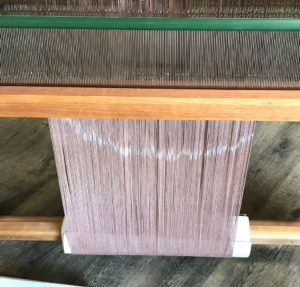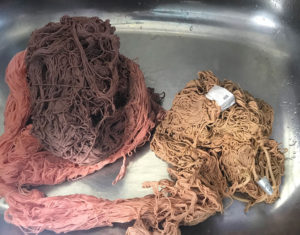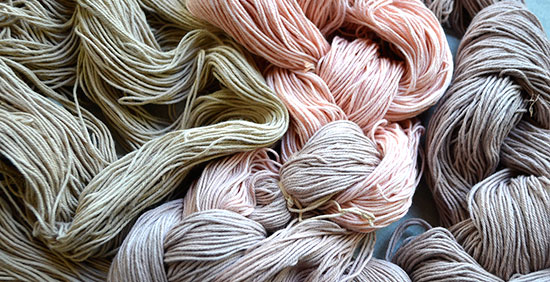I’ve been experimenting with the Bengala natural, sustainable mud dyes from Japan. These are used a lot by Saori studios around the world, such as Loop of the Loom. I now have a limited number of packs in stock. They are costly to import as Australia has tariffs on them but they are worth the colour.
I wanted to effectively use them in warps rather than completed fabric for shibori which is their most common use. They are VERY easy and safe to use. I didn’t need gloves (you may with sensitive skin) and it only took about 15 mins to get it all to the drying rack.
My first experiment was on a woven shibori cloth which was quite heavy. It was a twill weave in 10/2 mercerized cotton. This took a bit longer to dye and the woven shibori ties were not strong enough for the resist as they would have been for other dyes. The mud dye more effectively seeps into the yarn/cloth because of the manipulation of it during the dye process. This can be used as a benefit in woven work but it’s good to know how it all works. As an observation I’ve seen that Itajime shibori with shaped resists clamped to the cloth would mark out the shibori pattern in a defined way with these dyes.

For dyeing a warp I like to provide an opportunity for some casual patterning which doubles as secure ties for the warp. Normally we remove the warp choke ties in dyeing or painting a warp, or at least I do. But with the bengala we handle the yarn much more than normal so I make a thing of the choke ties and make them very tight. This also helps keep everything together in the dye bath. The main standard tie is always tight but make all the rest that way and add more! Of course, the tie for the cross must be left in and doesn’t need to be tight – but it is important! This gives instant ikat/kasuri style shifting line patterns to your warp as you will have a resist when you remove the choke ties after dyeing.
All of the Bengala dyes come with English instructions. The fixer is useful as it gives stronger colour to the dyes. Basically, I wet out the warp in a bucket of water, then used another bucket of water to add the fixer. The warp was manipulated and kneaded for about 1-2 mins, then rinsed out twice and spun in the washing machine. It was then ready for dyeing with the Bengala dyes.

Following the instructions, I dyed the entire warp with one colour, then took turns over dyeing with other colours in various segments, each time manipulating and kneading the yarn into the dye in the bucket for about 5 mins. The yarn was then rolled up in an old towel to remove most of the excess moisture and hung to dry. The colour is stable once it is dry.



